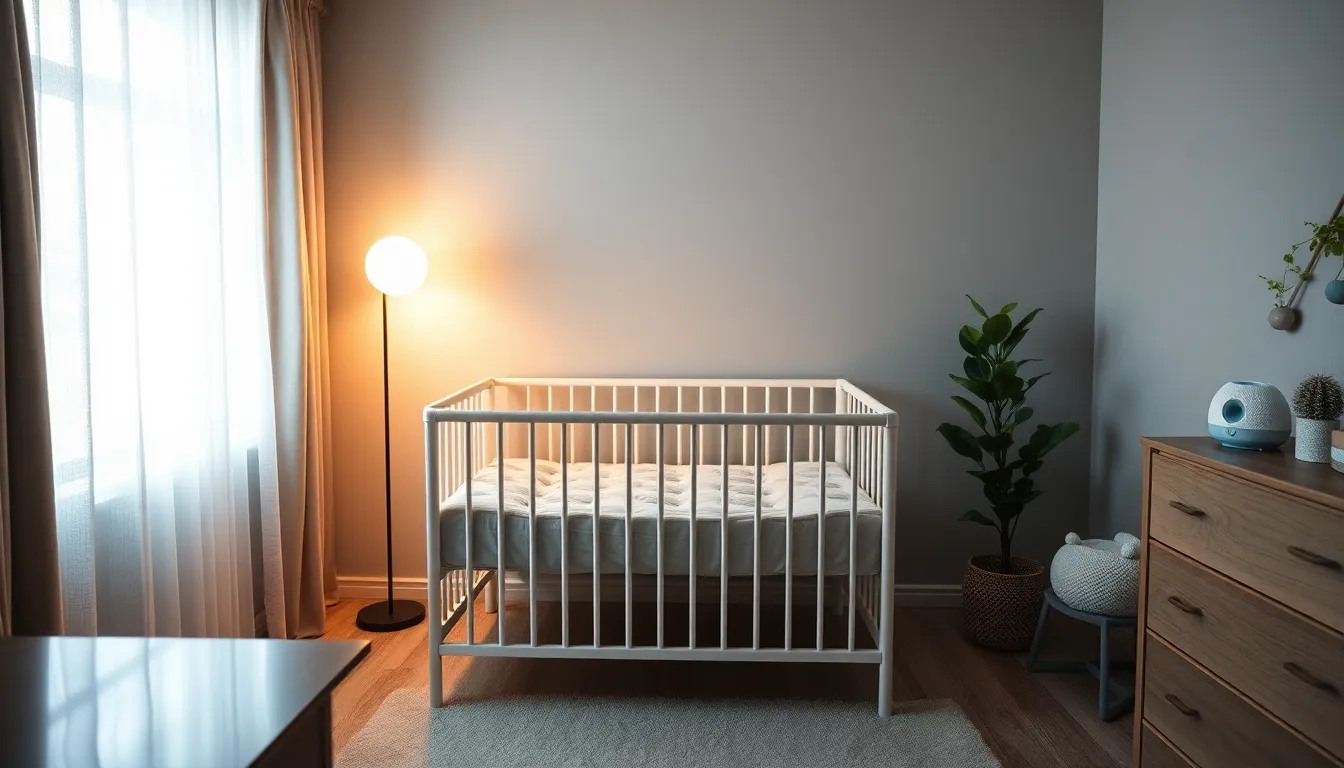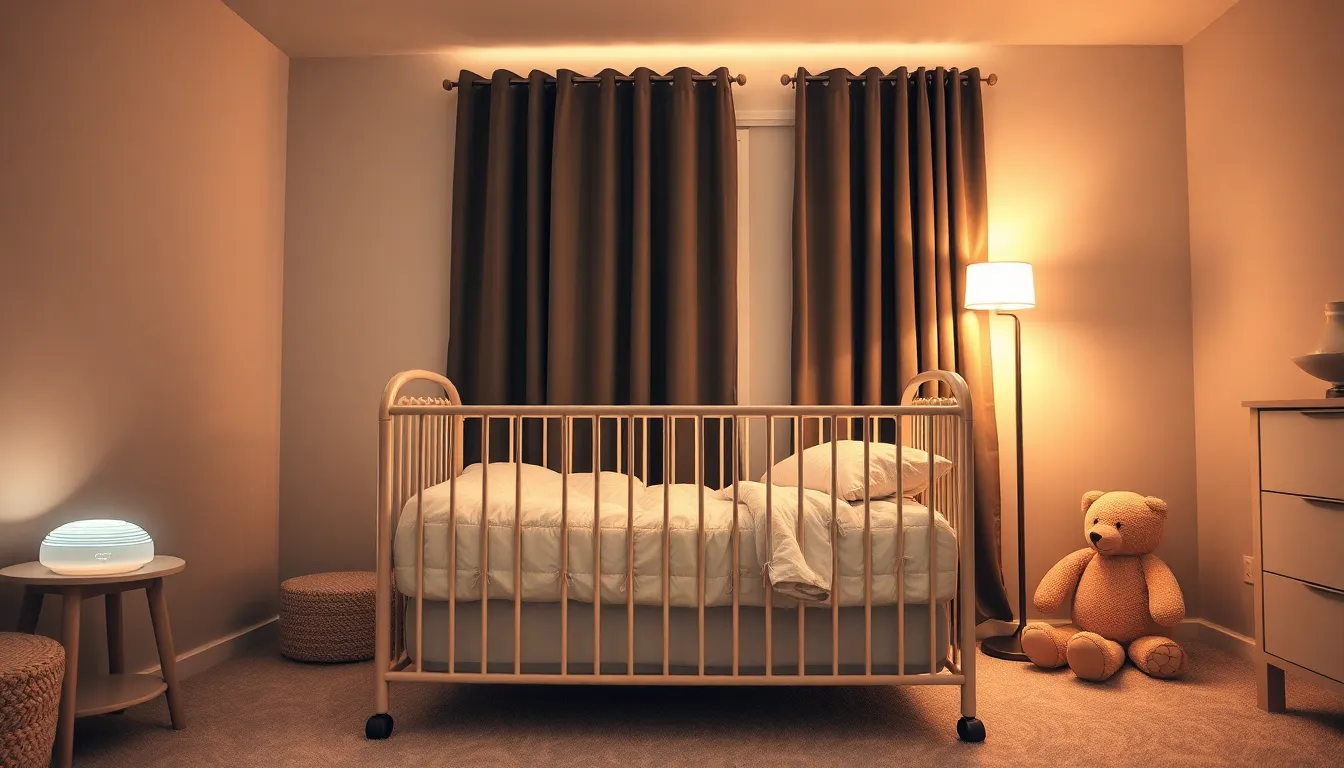Getting a baby to sleep can feel like trying to solve a Rubik’s Cube blindfolded. Just when parents think they’ve cracked the code, their little bundle of joy decides it’s time for a midnight dance party. But fear not! With a few clever tricks up their sleeves, parents can transform bedtime from a chaotic circus into a peaceful retreat.
Table of Contents
ToggleUnderstanding Baby Sleep Patterns
Understanding baby sleep patterns assists parents in fostering better sleep routines. Sleep varies significantly in newborns and infants, making awareness of these patterns essential.
Newborn Sleep Requirements
Newborns require 14 to 17 hours of sleep daily, often split into short sessions. Sleep typically occurs in stretches of 2 to 4 hours. Frequent waking for feeding contributes to this irregular pattern. Past the first few weeks, many newborns start settling into a more manageable routine.
Typical Sleep Cycles
Sleep cycles in infants differ from those in adults. Babies experience cycles lasting about 50 to 60 minutes, transitioning between light and deep sleep stages. Light sleep occurs first, making infants more prone to waking during this phase. Deep sleep follows, allowing for restful periods. Understanding these cycles aids parents in recognizing when a baby might naturally wake or transition back to sleep.
Creating a Sleep-Friendly Environment

Creating a calm atmosphere significantly influences a baby’s sleep quality. Parents can implement specific strategies to establish an inviting sleep-friendly space for their little ones.
Ideal Room Conditions
Optimal room conditions encourage relaxation. A cool temperature between 68°F to 72°F promotes a comfortable sleep environment. Dim lighting helps signal to the baby that it’s time to wind down. Sound machines or white noise devices mask disruptive noises, promoting longer sleep stretches. Keep clutter to a minimum, as an organized space feels more secure. Curtains that block light during naps enhance sleep quality, allowing the baby to drift off peacefully.
The Role of Sleepwear
Proper sleepwear matters for a good night’s sleep. Choose breathable fabrics like cotton that provide comfort and prevent overheating. Ensure outfits fit snugly without being restrictive, allowing for natural movement during sleep. Monitor the baby’s temperature; slight adjustments to sleepwear can help maintain comfort. Sleep sacks offer an alternative to blankets, providing warmth and safety. Selecting the right sleepwear supports a calming bedtime routine, fostering better sleep for babies.
Establishing a Bedtime Routine
Creating a consistent bedtime routine helps signal a baby that it’s time for sleep. This practice enhances relaxation and may improve sleep quality.
Key Components of a Routine
Successful routines often include a series of calming activities. Parents can start with a warm bath, followed by gentle massage. Reading a short story or singing lullabies can also create a soothing atmosphere. Dimming the lights and reducing noise further prepares the baby for sleep. Each component introduces predictability, establishing an environment that encourages sleep.
Timing and Consistency
Timing plays a vital role in developing a bedtime routine. Setting a specific bedtime fosters consistency, making it easier for the baby to recognize sleep patterns. Each night, aiming for the same bedtime reinforces the routine. If parents maintain this schedule on weekends, it creates stability. Consistency in the routine builds familiarity, helping the baby feel secure and relaxed before sleep.
Techniques for Soothing a Baby
Soothing techniques play an essential role in helping babies sleep better. Several effective methods can provide comfort and security.
Swaddling Methods
Swaddling newborns promotes a sense of security. Wrapping the baby snugly in a soft blanket mimics the womb, which often calms them. Proper swaddling involves using lightweight materials to prevent overheating. Ensure the baby’s hips have room to move, as tight swaddling can hinder natural movement. Adjust the swaddle as the baby grows; transitioning to different styles can suit changing preferences. Parents can explore various swaddling techniques, such as the traditional swaddle or the “arms-up” method, to find what works best for their baby.
White Noise and Music
White noise machines can mask disruptive sounds. Continuous, gentle sounds create a soothing atmosphere conducive to sleep. Sound machines simulate noises like rainfall or ocean waves. Additionally, soft music such as lullabies can lull babies into a peaceful state. Choose calming melodies that suit the baby’s temperament and preferences. Experimenting with different types of sounds can help parents discover what soothes their baby best. Keeping the volume at a low, safe level protects the baby’s hearing while providing a comforting background.
When to Seek Professional Help
Recognizing when to seek professional help is vital for ensuring a baby’s well-being and sleep health. Parents should stay vigilant and look for specific signs.
Signs of Sleep Disorders
Certain indicators may suggest sleep disorders in babies. Frequent difficulty falling asleep or staying asleep can signal underlying issues. Excessive crying or fussiness around bedtime also raises concerns. Observing sleep patterns is crucial; if a baby routinely sleeps fewer than 12 hours or experiences unusual movements during sleep, consulting a professional becomes necessary. Moreover, if daytime drowsiness significantly impacts alertness or feeding, it is wise to seek guidance. Tracking these behaviors allows parents to identify potential problems early.
Consulting a Pediatrician
Consulting a pediatrician proves essential when sleep disruptions persist despite implementing strategies. Professional advice will help alleviate concerns and guide parents on next steps. Pediatricians can evaluate sleep patterns and identify possible medical causes. Recommendations may include a referral to a sleep specialist for more comprehensive assessment. Having open communication about sleep issues encourages parents to address their child’s unique needs. Taking action early increases the chances of establishing healthy sleep habits for the baby.
Getting a baby to sleep can feel overwhelming but with the right strategies in place, parents can create a peaceful bedtime routine. Understanding sleep patterns and cycles is crucial in fostering better sleep habits. By establishing a calming environment and consistent routines, parents can help their babies feel secure and relaxed.
Incorporating soothing techniques and monitoring sleep conditions can make a significant difference in sleep quality. When challenges persist, seeking professional guidance can provide valuable insights and support. With patience and persistence, parents can navigate the journey of sleep, ultimately leading to more restful nights for everyone.


